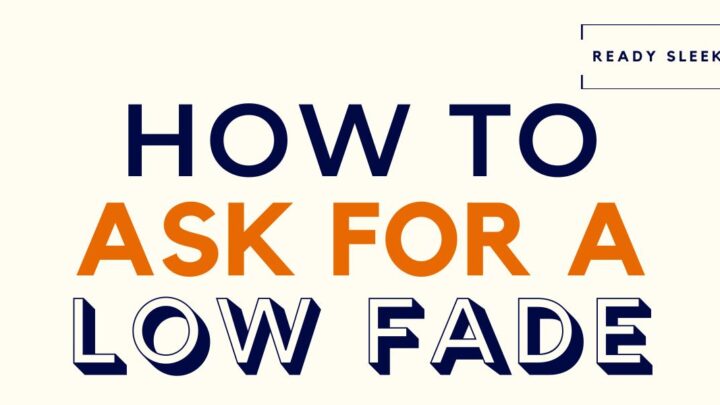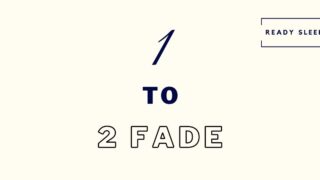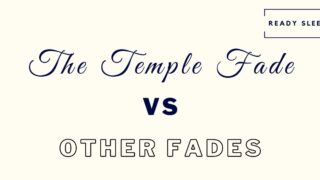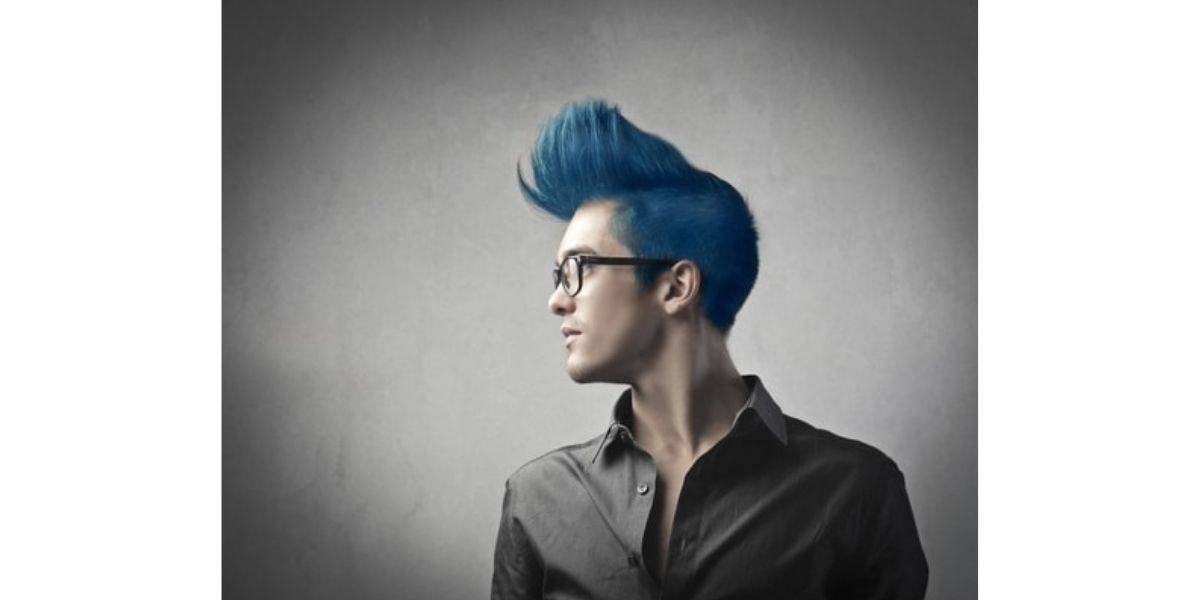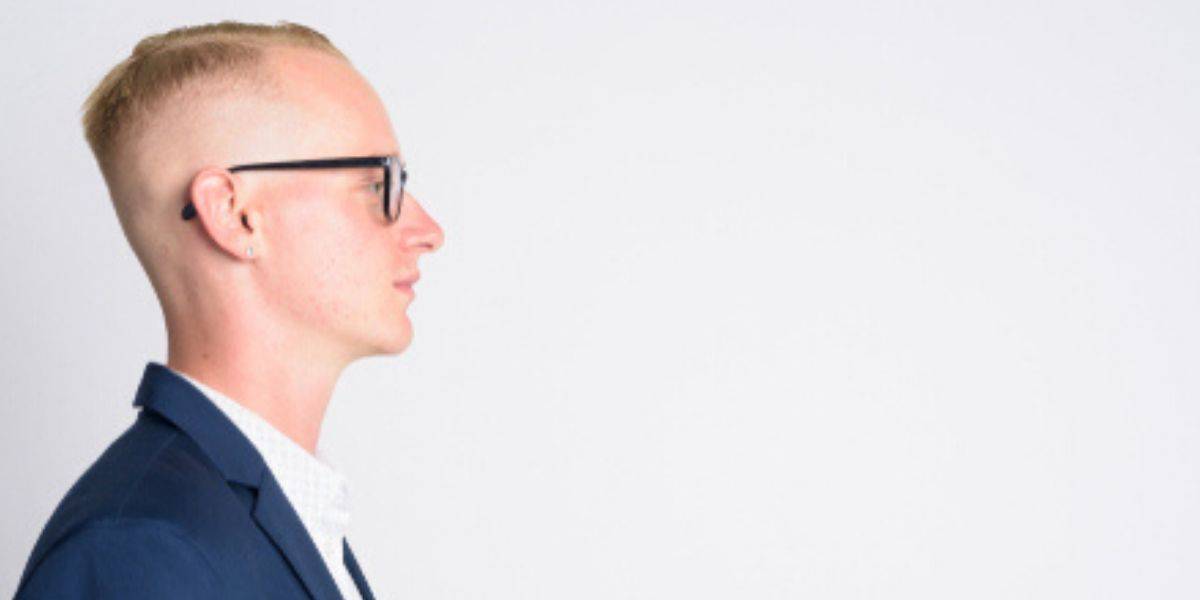Poor communication between barbers and their clients is pretty common, unfortunately. It’s a key reason why so many people don’t get the fade they really want. So, how exactly do you ask for a low fade?
To ask for a low fade, let the barber know you want the fade to reach approximately half an inch above the ear. In addition, let them know how short you want the shortest length of the low fade to be, as well as what length you want it to transition into.
Although that’s the short answer, there’s more to it.
We’ll be going through the exact step-by-step routine to use whenever asking for a low fade. But first, it’s important to know exactly what a low fade is in the first place.
Let’s get to it.
Know Exactly What A Low Fade Is
A “fade” is an effect where the sides gradually increase in length as you go from the bottom to the top. A “low fade” is a type of fade where this gradual increase in length starts to occur approximately half an inch above the ear.
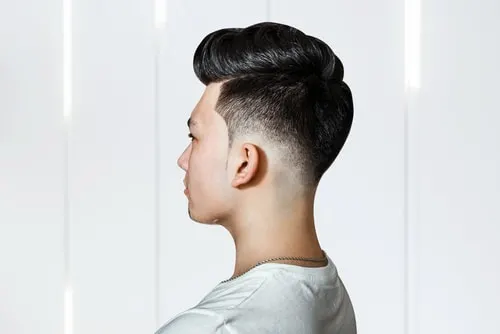
At this point, the shortest length of the fade starts to transition and blend into longer lengths as you go up toward the top of the sides.
So, the “line” of the fade only reaches as high up as half an inch above the ear.
The characteristic blurred appearance of a fade occurs due to the different lengths being blended seamlessly into each other using clipper technique.
As the shortest length of the fade doesn’t reach very high up the sides before transitioning, low fades have quite a subtle appearance to them.
It’s worth comparing them with mid fades and high fades.
“Mid” fades also gradually increase in length as you go up the sides and back. However, the point at which the transition takes place is higher than with low fades – around 1 inch above the ear usually.
As a result, around half of the sides would appear to be trimmed down to their shortest length. This makes mid fades look more striking and attention-grabbing than low fades.
“High” fades reach even higher, with the transition point being around the level of the temples. Due to this, most of the sides and back would be trimmed down to their shortest length.
This is bold, striking, and definitely attention-grabbing.
But telling a barber you want a low fade isn’t enough, as you’ll need to tell them how short you want the shortest length of the low fade to be.
In other words, how short do you want the hair at the bottom of the sides and back before it transitions up into longer lengths once you reach half an inch above the ear?

I’ll be going through the specifics in the routine you’ll read later on.
Summing this all up, a low fade is defined by the height it reaches at the sides.
Essential Low Fade Terminology
Speaking to a barber can sometimes be a surprisingly stressful experience. This is usually due to clients not having a good grasp of the lingo that’s commonly used.
Here are some terms you need to know if you want to confidently ask a barber for a low fade and be sure you’ll get the outcome you want:
- Fade – Where the hair at the sides and back appears to gradually increase as you go up, with the different lengths seamlessly blending into each other.
- Low/Mid/High – Terms that refer to the height that the shortest length of the fade reaches.
- Skin Fade – A feature where the shortest length of the fade is shaved all the way down to the skin. Low, mid, and high fades can all be skin fades – all that matters is that the shortest length is shaved.
- Number – This is how barbers refer to the length their clipper will trim down to. The numbers correspond to specific lengths (eg. number 1, number 2, etc).
Let’s talk more about clipper guard “numbers”. Getting this part wrong can literally ruin a request for a low fade because they’re commonly confused.
When asking for a low fade, you’ll need to tell the barber how short you want the shortest length of the fade to be (i.e below the transition point that lies half an inch above the ear).
In addition, you’ll need to tell them what length you want it to transition into as you go up to the top of the sides and back.
For example, a low fade could be a number 1 (i.e #1) length at the bottom, before gradually transitioning into a #3 length further up the sides.
You’d ask for a “number 1 into a number 3”.
It would start this transition approximately half an inch above the ear. During this transition, the barber would most likely blend the #1 length into a #1.5, then into a #2, before finally getting to the #3.
They would use the clipper lever to ensure that there aren’t any harsh or even visible lines between the different lengths. That’s what gives fades their typical blurred appearance.
A very common mistake is for people to believe that the clipper guard number refers to the exact length it’ll trim down to in inches or millimeters.
This isn’t correct.
Here’s a list of the common mainstream clipper guard numbers and the exact lengths they trim down to:
- #0 – 1/16 inch
- #1 – 1/8 inch
- #2 – 1/4 inch
- #3 – 3/8 inch
- #4 – 1/2 inch
- #5 – 5/8 inch
- #6 – 3/4 inch
- #7 – 7/8 inch
- #8 – 1 inch
How To Ask A Barber For A Low Fade (5 Steps)
While the information above would most likely see you through, having a simple, step-by-step routine when asking for a low fade is the most effective way to get the result you want.
By the end of this, you should be able to request a low fade in a similar way to this:
“I’d like a low fade, please. I don’t want it to go higher than around here [physically point to around half an inch above the ear]. Please fade from a #0 at the bottom into a #2 further up. Trim an inch of the top – a comb-over to the left would be great. I don’t need a line-up”.
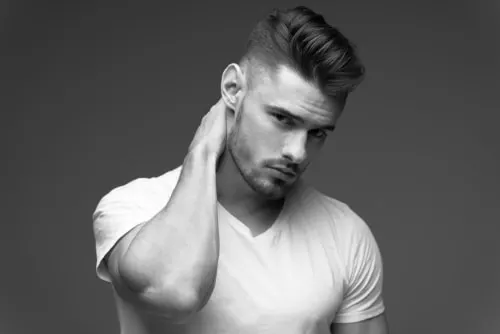
1. Find A Photograph
This is, by far, the most productive thing you could do before you visit your barber. Finding a photograph of the exact type of low fade you want will make it much easier for your barber to give you the result you want.
Find a photo of a low fade set at the exact height you want it, with the exact lengths you want as well.
If the top is cut the way you want it too, even better.
The reason this is so effective is that it can be tough for a non-barber to know what specific lengths actually look like.
You may look at a photograph and think it’s a #1 at the bottom. In reality, it may be a #2 or something else.
A photograph would take the guesswork out of it. A good barber would be able to look at it and instantly know what lengths you want and where you want that low fade to really sit.
It would be wise to ask the barber what lengths they’re going to use for the low fade, simply because you’d then be able to specifically request it in future visits even when you don’t have a photograph to hand.
2. Specify The Fade Height
Let’s assume, for the sake of this routine, that you don’t have a photograph to hand or you simply can’t find one with the lengths you want.
While telling the barber you want a low fade should lead to a fade height you’ve got in mind, the term can sometimes mean different things to different people.
Because of this, it would be wise to make it extra clear right from the start.
Tell the barber you want a low fade while using your finger to point to around half an inch above the ear. Let them know you don’t want the fade any higher than this point.
3. Specify The Fade Lengths
At this point, you’ll need to let the barber know how short you want the shortest length of the low fade to be at the bottom of the sides and back.
In addition, you need to tell them what length you want it to transition into as you go up the sides and back.
As I explained in the “Essential Low Fade Terminology” section earlier, this is usually done by telling them what clipper guard numbers you want to be used.
For example, if you wanted the shortest length shaved all the way down, tell them you want a low skin fade.
If you want it to transition into a #2 length at the top of the sides and back, tell them you want a “low skin fade into a #2”.
The same goes no matter what you want the shortest length of the low fade to be.
It could be a #0.5, a #1, or a #2. It’s unusual to have the shortest length of a fade any longer than this, however.
Whatever you choose, however, you’ll also need to let them know what you want it to blend into as you go up.
4. Say What You Want For The Top
By “top”, I mean the top of the head. Up until now, all you’ve told them is what you want to do with the sides and back.
You’ll need to tell them whether you want the top buzzed or scissor-cut.
Do you want a pompadour, a comb-over, a slick back, a quiff, or anything else?
The options are endless, but it’s important to know approximately how much you want to be trimmed off the top, as well as how you intend on styling it.
Practically any hairstyle you can think of can incorporate a low fade. Once again, a photograph that shows exactly what you want would be very helpful if you can get your hands on one.
5. Say Whether You Want A Line-Up
A “line up” is a feature where the edges of the hairline (at the sides, back, and front) are made to look more defined using a straight razor.
They’re also called “shape ups” or “edge ups”.
It isn’t essential to get a line up by any means. Many people prefer a more natural appearance to their hairline.
But if you did want a line-up, it’s important to tell the barber before they start trimming. You could tell them at the end, but it wouldn’t be ideal.
After this, you’re done.
Conclusion
Requesting a low fade is often made more complicated than it needs to be, but it’s true that there’s plenty that can go wrong when you don’t understand the fundamentals of what a low fade really is.
Hopefully, you’re now much closer to getting the exact low fade you’ve got in mind.
Enjoy.
Ready Sleek founder. Obsessed with casual style and the minimalist approach to building a highly functional wardrobe. Also a fan of classic, vintage hairstyles.

